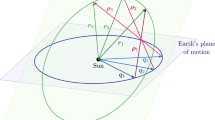Abstract
If the force field acting on an artificial Earth satellite is not known a priori with sufficient accuracy to represent its observations on their accuracy level, one may introduce so-called pseudo-stochastic parameters into an orbit determination process, e.g. instantaneous velocity changes at user-defined epochs or piecewise constant accelerations in user-defined adjacent time subintervals or piecewise linear and continuous accelerations in adjacent time subintervals. The procedures, based on standard least-squares, associated with such parameterizations are well established, but they become inefficient (slow) if the number of pseudo-stochastic parameters becomes large. We develop two efficient methods to solve the orbit determination problem in the presence of pseudo-stochastic parameters. The results of the methods are identical to those obtained with conventional least-squares algorithms. The first efficient algorithm also provides the full variance–covariance matrix; the second, even more efficient algorithm, only parts of it.
Similar content being viewed by others
References
Beutler G (2005) Methods of celestial mechanics. Springer, Berlin Heidelberg New York
Beutler G, Brockmann E, Gurtner W, Hugentobler U, Mervart L, Rothacher M, Verdun A (1994) Extended orbit modeling techniques at the CODE processing center of the international GPS service for geodynamics (IGS): theory and initial results. Manuscr Geod 19:367–386
Colombo OL (1989) The dynamics of global positioning orbits and the determination of precise ephemerides. J Geophys Res 94(B7):9167–9182
Dow JM, Neilan RE, Gendt G (2005) The international GPS service: Celebrating the 10th anniversary and looking to the next decade. ASR 36(3):320–326
Hugentobler U, Schaer S, Beutler G, Bock H, Dach R, Jäggi A, Meindl M, Urschl C, Mervart L, Rothacher M, Wild U, Wiget A, Brockmann E, Weber G, Habrich H, Boucher C (2003) In: Gowey K (ed) CODE IGS Analysis Center technical report 2002. IGS Central Bureau, Jet Propulsion Laboratory, Pasadena
Hugentobler, U, Dach R, Fridez P (2005) Bernese GPS software, version 5.0. Printing Office, University of Bern
Jäggi A, Hugentobler U, Beutler G (2004) Efficient stochastic orbit modeling techniques using least squares estimators. In: Sansó F (ed) A window on the future of geodesy. Springer, Berlin Heidelberg New York, pp 175–180
Jäggi A, Hugentobler U, Beutler G (2006) Pseudo-stochastic orbit modeling techniques for low Earth orbiters. J Geod 80(1):47–60
Press WH, Teukolsky A, Vetterling WT, Flannery BP (1996) Numerical recipes in Fortran 77—the art of scientific computing, 2nd edn. Cambridge University Press, Cambridge
Strang G, Borre K (1997) Linear algebra, geodesy, and GPS. Wellesley, Cambridge
Švehla D, Rothacher M (2002) Kinematic orbit determination of LEOs based on zero- or double-difference algorithms using simulated and real SST GPS data. In: Ádam J, Schwarz K-P (eds) Vistas for geodesy in the new millennium. Springer, Berlin Heidelberg New York
Švehla D, Rothacher M (2003) CHAMP double-difference kinematic POD with ambiguity resolution. In: Reigber C, Lühr H, P (eds) First CHAMP mission results for gravity, magnetic and atmospheric studies. Springer, Berlin Heidelberg New York
Teunissen PJG, Kleusberg A (eds) (1998) GPS for geodesy. Springer, Berlin Heidelberg New York
Visser PNAM, van den IJssel J (2003) Aiming at a 1-cm orbit for low Earth orbiters: reduced-dynamic and kinematic precise orbit determination. Space sciences series of ISSI. Earth gravity field from space—from sensors to Earth sciences. Kluwer, Dordrecht
Zumberge JF, Heflin MB, Jefferson DC, Watkins MM, Webb FH (1997) Precise point positioning for the efficient and robust analysis of GPS data from large networks. J Geophys Res 102(B3):5005–5017
Author information
Authors and Affiliations
Corresponding author
Rights and permissions
About this article
Cite this article
Beutler, G., Jäggi, A., Hugentobler, U. et al. Efficient satellite orbit modelling using pseudo-stochastic parameters. J Geodesy 80, 353–372 (2006). https://doi.org/10.1007/s00190-006-0072-6
Received:
Accepted:
Published:
Issue Date:
DOI: https://doi.org/10.1007/s00190-006-0072-6




